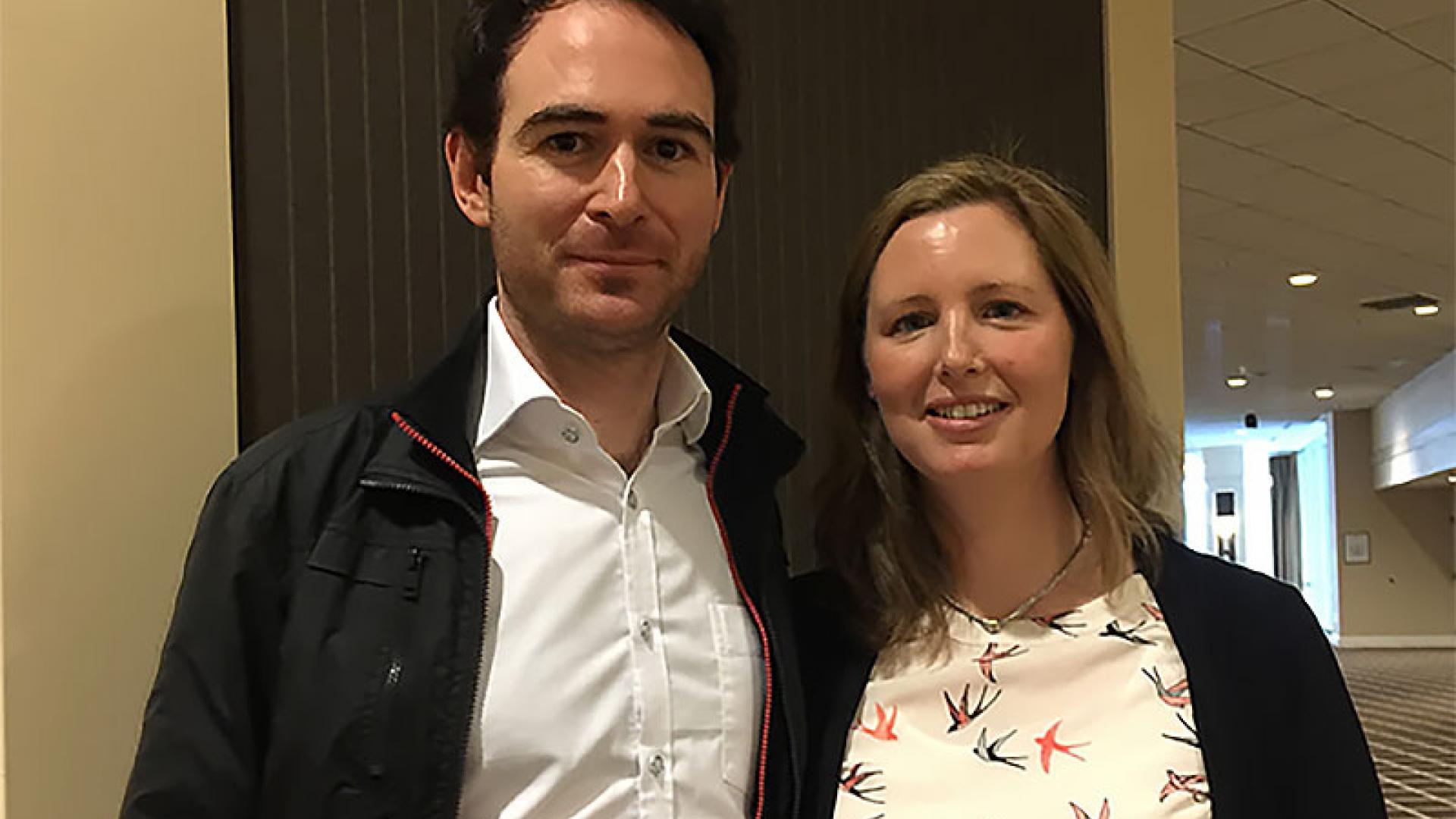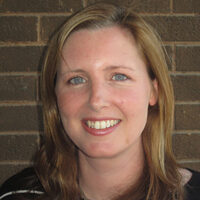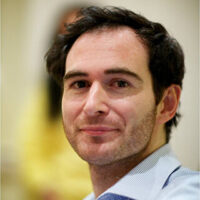Close-up: The Husband-Wife Research Team of Matthew Campbell and Sarah Doyle
Written By: BrightFocus Editorial Staff
Written By: BrightFocus Editorial Staff

As co-investigators on past BrightFocus grants, Sarah Doyle, PhD, and Matthew Campbell, PhD, have made ground-breaking discoveries into the biology of neurodegeneration. Both are assistant professors in the Institute of Neurosciences at Trinity College Dublin. Sarah’s expertise lies in immunology and her lab is investigating inflammatory factors in age-related macular degeneration (AMD). Matt runs a Neurovascular Genetics research program at the Smurfit Institute of Genetics, where he’s studying the blood-brain and blood-retina barriers as potential interception points for delivering treatments and removing toxins from the eye and brain.
Both have been recognized by leading research authorities in Ireland and internationally, and Sarah is a member of the BrightFocus Macular Degeneration Research (MDR) Scientific Review Committee.
Their BrightFocus-funded research collaboration into inflammatory factors in AMD began in 2011, when Campbell was co-principal investigator on a 2011-13 MDR grant to their Trinity mentor and colleague, Peter Humphries, PhD. Doyle was a collaborator and their results, published in in 2014 (Doyle et al, Science Translational Medicine) received a lot of attention for the unexpected and revelatory discovery that an inflammatory factor, interleukin-18, plays a protective role against neovascularization in wet AMD. (Read more about this unexpected discovery.).
They went on to investigate toll-like receptors as a possible mechanism regulating the inflammatory response in AMD, this time supported by a 2013-16 MDR grant to Sarah, with Matt and another TCD colleague, Luke O’Neill, PhD, as co-PIs. Then Matt veered off in a slightly different direction with an Alzheimer’s Disease Research (ADR) grant from BrightFocus to study “tight junction” proteins controlling the blood-brain barrier as a possible mechanism for clearing amyloid-beta and other toxins in Alzheimer’s disease, which he talks about in the following interview. Meanwhile, with a 2016-19 MDR grant, Doyle pursued additional research into the regulatory role of toll-like toll-like receptor 2 (TLR2) in wet AMD.
Recently, when results from Doyle’s latest grant were published (Mulfaul et al, Cell Reports, 2020), it became clear that the couple’s separate research pursuits have once again converged. Matthew’s name is listed next to Sarah’s as a senior author, and he’s credited with experiments showing that oxidative stress-induced TLR2 signaling reduces tight junction expression and is a likely factor that contributes to damage of RPE cells and the outer blood retinal barrier. In other words, as Campbell predicted below, their separate MDR and ADR research pathways overlapped in the vasculature of the retina.
These results also represent an exciting convergence of the BrightFocus “mind” and “sight” research programs. What follows below is a 2016 interview with Doyle and Campbell that was published on the BrightFocus website. That long-ago conversation describes their highly successful working relationship and sets the stage for their latest research accomplishments, which move the world closer to AMD cures.
The following is a reprint of a 2016 interview with Trinity College Dublin scientists Sarah Doyle, PhD, and Matthew Campbell, PhD.
Q Did you two happen to meet in the laboratory—or where?
A. (Doyle). We met when we were 17, in the south of France on holiday. As it turned out we lived within 10 minutes of each other in Dublin and had common friends, but we had never met!
Q Where did you grow up, and what led you into research?
A. (Doyle). We grew up in a suburb of Dublin called Castleknock (Ireland). I seemed to take a natural route into research, I was always interested in the natural world growing up. After two years in natural sciences in Trinity, I knew I wanted to pursue molecular biology. I chose to study biochemistry for my degree and molecular immunology for my PhD. I still love asking questions and designing experiments to answer them. My parents weren’t surprised at all that I ended up as a scientist, apparently I never stopped with the “why” “where” and “how” questions!
Q What’s the best part about working together as scientists?
A. (Doyle). I think we have a great understanding of what we each do and the various pressures that our jobs can entail. Speaking about our research and what we did that day without using technical jargon is difficult, so its nice that we know what each other is talking about all the time!
Q And the hardest?
A. (Doyle). We have to decide who gets to go to which meetings, and who will watch the children when we both go to ARVO!
Q What are the special talents each of you brings to a research collaboration?
A. (Doyle). Aside from the obvious difference in our expertise, Matt is much better at explaining what he and we do in ordinary language. He speaks really well and engages with his audience. I think writing comes more easily to me though!
Q Does either of you have any irritating lab habits?
A. (Doyle). I’m not sure…thankfully we each have our own labs in separate buildings.
Q [to Matthew Campbell] A couple years back you were awarded the President of Ireland Young Investigator award from Science Foundation Ireland. What was that like?
A. (Campbell). It was a huge honor to receive this award. The grant gave me an incredible platform to establish my own laboratory here in Trinity and has allowed me to recruit some seriously talented PhD students and postdoctoral researchers. I was presented the award by Michael D Higgins, the President of Ireland at a ceremony in his house (Áras an Uachtaráin). Quite the privilege!
Q We mostly know you as a “vision” researcher; however, last year you applied for and received a BrightFocus grant to study Alzheimer’s. What led you in that direction?
A. (Campbell). My lab is focused on understanding the biology of blood vessels associated with neural tissues so we have a very keen interest in brain as well as retinal diseases. In fact the retina is an external part of the brain that just happens to be light sensitive. Current projects are focused on traumatic brain injuries (TBI), schizophrenia and Alzheimer’s disease (AD). My work on Alzheimer’s is primarily focused on how the brain rids itself of junk and our work has already led to some intriguing findings. We’ve shown that toxic material called amyloid, that builds up in AD patients brains, can squeeze between the cells that line blood vessels in the brain. If we can better understand how toxins are cleared from the brain, it may lead to new forms of therapy that can facilitate the process.
Q Are your eye and brain research complementary?
A. (Campbell). Yes, there’s a similar process occurring with drusen in AMD, with the eye’s inability to get rid of waste material, so it accumulates and starts to affect other tissues. The eye, too, has an eye-blood barrier, and AMD also appears to be, in part, a disease of aberrant clearance.
Q How will your research contribute to new AMD treatments?
A. (Doyle). The more we understand about the disease processes underlying AMD, the better placed we’ll be to contribute to new AMD treatments. Our work with IL-18 as a therapeutic for wet AMD is ongoing, and we are hopeful that from our basic research started in 2011 that we will have a new tool for treating this condition.
[Watch a video on their discovery: https://www.youtube.com/watch?v=QkjDkH5yDe4.]
Q What are the next big ideas you’d like to pursue?
A. (Doyle). We have some intriguing data relating to the development of geographic atrophy, the end stage of dry AMD. We are still in the process of compiling all of our results but we think we may have stumbled upon a new series of therapeutic targets for the disease. Hopefully we’ll be ready to publish these data by the end of the year!
Q. What would you say to the BrightFocus donors who have sponsored your research?
A. (Doyle). Thank you, thank you, thank you! You really have allowed us to explore some research questions that could be termed ‘high risk’ and that might have difficulty getting funding elsewhere. Hopefully, in tandem with increasing our knowledge about AMD pathology, we can improve treatment for AMD in the future.
BrightFocus Foundation is a premier global nonprofit funder of research to defeat Alzheimer’s, macular degeneration, and glaucoma. Since its inception more than 50 years ago, BrightFocus and its flagship research programs—Alzheimer’s Disease Research, Macular Degeneration Research, and National Glaucoma Research—has awarded more than $300 million in research grants to scientists around the world, catalyzing thousands of scientific breakthroughs, life-enhancing treatments, and diagnostic tools. We also share the latest research findings, expert information, and resources to empower the millions impacted by these devastating diseases. Learn more at brightfocus.org.
Disclaimer: The information provided here is a public service of BrightFocus Foundation and is not intended to constitute medical advice. Please consult your physician for personalized medical, dietary, and/or exercise advice. Any medications or supplements should only be taken under medical supervision. BrightFocus Foundation does not endorse any medical products or therapies.

Trinity College Dublin (Ireland)

Trinity College Dublin (Ireland)
Help Fight Macular Degeneration and Save Sight
Your donation helps fund critical research to bring us closer to a cure for this sight-stealing disease and provide vital information to the public.
Donate Today